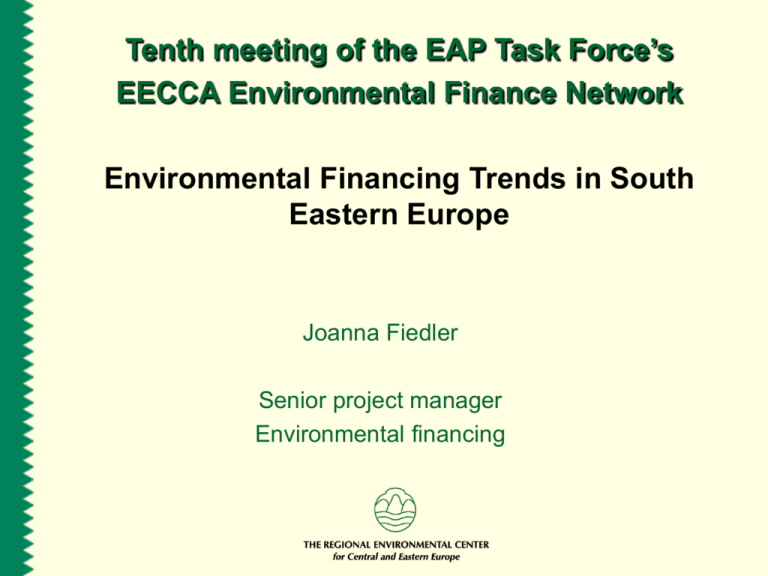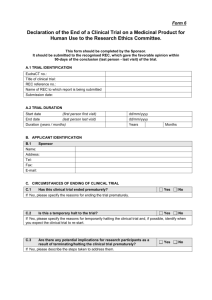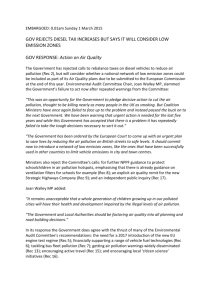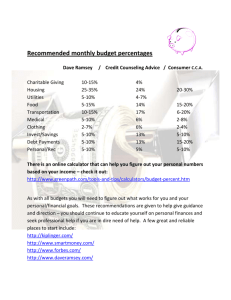REC Powerpoint template
advertisement

Tenth meeting of the EAP Task Force’s EECCA Environmental Finance Network Environmental Financing Trends in South Eastern Europe Joanna Fiedler Senior project manager Environmental financing Outline • • • • • • Introduction to the report, status of work; SEE region context; Key messages; Domestic environmental expenditures; International flows to environment; Financial mechanisms in use. www.rec.org Introduction to the report • Category II document for Belgrade Ministerial conference. • Follow up to the “Environmental financing trends report” for Kiev conference http://www.rec.org/REC/Programs/SofiaInitiatives/Enviro. Finance.in.CEE.pdf • The main goal of the report is to propose recommendations for decisions-makers in the region so that they could take action and ensure more environmental funding schemes and resources for environmental actions. www.rec.org • Major economic and environmental trends which were influencing the situation on environmental financing in the SEE between 2001 and 2005; • Presenting trends in domestic environmental expenditures in the SEE; • Analyzing international financing flows to the region including bilateral and multilateral sources; • Analyzing established and emerging financing mechanisms in the region and their development potential in the future; • Identifying new possible financing mechanisms which could be developed in the future; • Providing recommendations to decision makers on improving effectiveness of environmental financing from both domestic and external financing sources. www.rec.org Trends in bilateral donors commitments Others 7.7 % US 7 % Norway 6.2 % Germany 39 % Netherlands 5.7 % Japan 17.6 % Source: OECD DAC data base Austria Denmark Germany Italy Japan Netherlands Norway Spain Sweden United States Others Others = Donor countries with less than 3% share of toatal aid www.rec.org Source: OECD DAC data base Recipients of assistance 35 30 25 20 15 10 5 0 Albania BiH Croatia fYROM UNMIK Share of Total Bilateral Environm ental Aid per Recipient Countries (in %) Serbia and Montenegro 100.00 90.00 80.00 70.00 60.00 50.00 40.00 30.00 20.00 10.00 0.00 Albania BiH Croatia fYROM Bilateral Environmental Aid per Recipient Countries (usd / capita) UNMIK Serbia and Montenegro www.rec.org Preliminary trends in assistance Source: OECD DAC data base % 2.5 2 1.5 1 0.5 2004 2003 2002 2001 Serbia and Montenegro UNMIK Total Bilateral Environmental Aid per country in relation to GDP (expressed in %) (including the Zletovic project) fYROM Croatia BiH Albania 0 www.rec.org Importance of different sources of finance for infrastructure projects over the time high importance public finance EC user charges medium importance private sector IFIs bilateral donors low importance 1 2 3 4 5 from 5 onwards short term years EU accession medium term long term www.rec.org Key messages • Environment low on political agenda on central and local levels • Decentralisation process not supported by allocation of fiscal means • Low level of domestic financial resources for environment • EU role is increasing, bilateral donors role decreasing, IFIs – struggling (borrowing legislation) • Important role of economic instruments www.rec.org Key messages • Potential for innovative financial mechanisms (private sector, carbon finance etc) • Presenting environmental projects as contributors to growth and employment • Creating favorable conditions for borrowing, • Important role of capacity building and technical assistance • Assistance needed on project preparation • Need for diversification of sources of finance www.rec.org Thank you for your attention Joanna Fiedler Senior project manager Environmental financing and economic instruments Environmental Policy Programme Regional Environmental Center for Central and Eastern Europe jfiedler@rec.org







